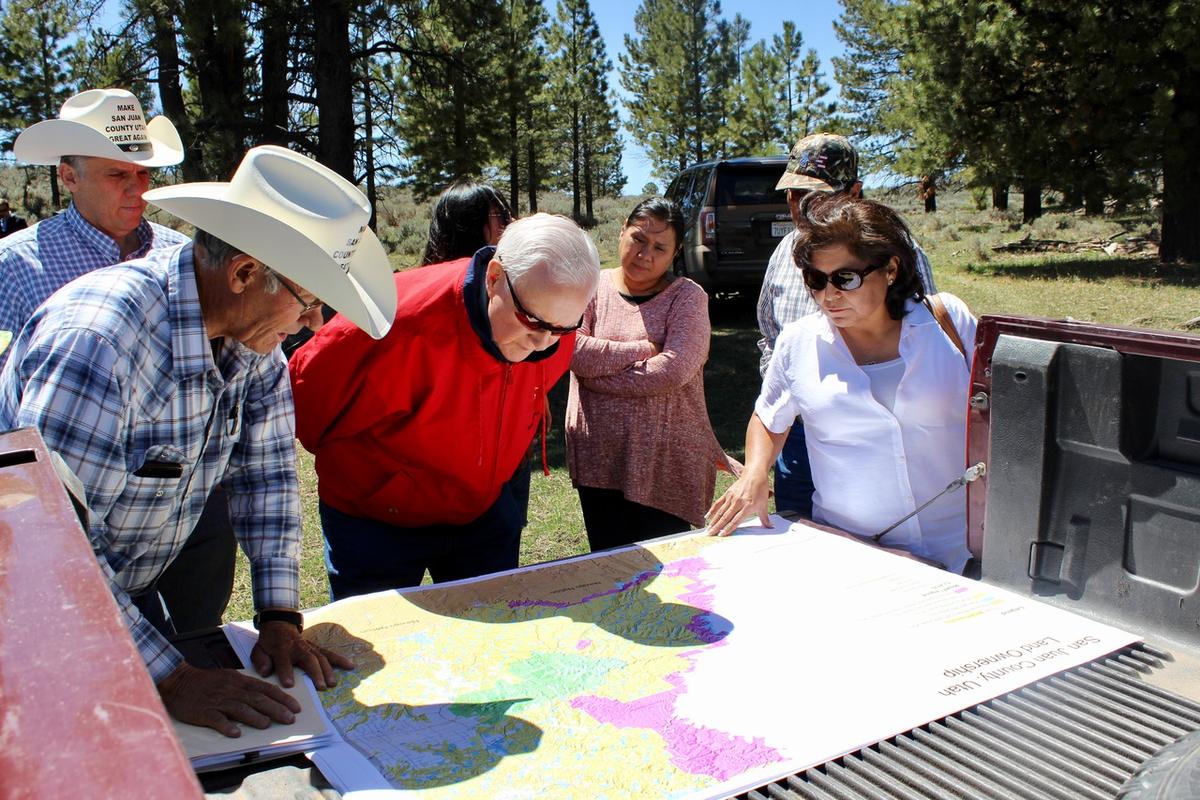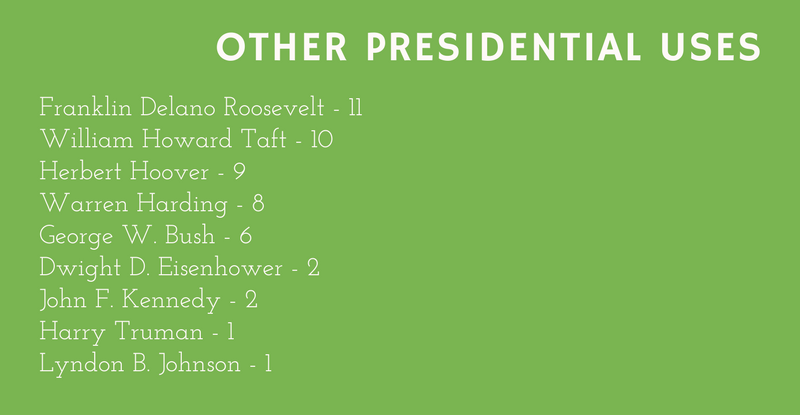May 8, 2017
It seemed to be a fight of locals against federal government and special interest groups that culminated in Barack Obama’s Dec. 28 designation of the Bears Ears National Monument. But the conflict didn’t end with the stroke of a pen in the Oval Office. The battle rages on between Democrats and Republicans, locals and politicians, businesses and tribal governments. It has captured the attention of residents, the southwest region, major news outlets, and at least two presidents. This episode is just one in a series of public lands issues that have existed in Utah before the Beehive State was even part of the United States.
Timeline
Both sides of the story
An examination of Utah’s public lands debates in the past few decades reveals that in each of these conflicts, proponents and the opponents have provided similar reasons as their predecessors for their views.
It’s the big guys versus the little guys. The underrepresented minority versus the pushy majority. Good versus evil. But who belongs to which team? It depends on who you ask.
Why an opposition?
- Potential increase in vandalism
- Lack of trust because of previous Utah national monument history
- Unnecessary outside influences
- Economic threat
- Strain on natural resources
- Destruction of Native American tradition
- Restrictions on wood gathering and hunting
- Overstepping present regulations
- Loss of education funding from trust lands
Why a supportive movement?
- Protecting Native American lands and cultural tradition
- Prevent harmful coal and oil development
- Prevent economic interests outweighing environmental protections
- Promote public land use for all Americans
- Promote healthy tourism habits, increase Utah’s economy
- Proper use of the Antiquities Act
Politicians
Gov. Gary Herbert signed a resolution in February urging President Trump to rescind the Bears Ears National Monument designation. Both supporters and opponents say that rescinding the designation would loosen federal control of Utah’s public lands and give a lot of power to the state, but there’s heavy disagreement as to whether that’s a positive thing.
Herbert made a trip to Washington D.C. the week of March 27, apparently to persuade Secretary of the Interior Ryan Zinke to visit the Bears Ears National Monument as his predecessor, Sally Jewell, did in July 2016 before the monument was designated. Zinke described himself as a Theodore Roosevelt-style conservationist when it comes to national parks and land conservation. He is unlike many conservative Republicans on environmental issues – he has said he doesn’t think climate change is a hoax. But he’s pretty conservative when it comes to state control of public lands.
Herbert told reporters after his visit that Zinke seems to agree with Utah officials that the sacred tribal lands at Bears Ears need protections, but those designated by the Utah legislature or Congress, not a president.
U.S. Rep. Jason Chaffetz, R-Utah, is the chair of the congressional Government Reform and Oversight Committee. Chaffetz expressed outrage when, shortly after Obama designated the monument, a National Parks Twitter account posted excitement about the designation alongside a picture of an area of southern Utah that is not part of Bears Ears. Chaffetz pointed to this gaffe as a reason why “outsiders” should not be involved in Utah public lands issues.
U.S. Rep. Rob Bishop, R-Utah, has been a vocal supporter and sponsor of the Public Lands Initiative, a sometimes-controversial attempt to find compromise between federal and state control of Utah’s public lands.
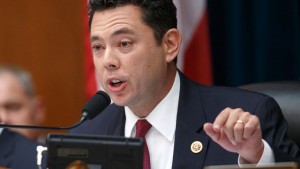
Rep. Jason Chaffetz
Officials with environmental organizations that support stricter federal protection said they initially worked with Bishop on the Initiative. But several of them said they dropped out of the conversation because too many business-motivated interests had made their way into the Public Lands Initiative.
When Jewell, the former Interior Secretary, visited southeastern Utah in July 2016, she told locals she wanted to hear their point of view.
“I know there’s a lot of emotions running hot about the beauty of San Juan County and how to take care of it, and that’s why I’m here,” Jewell said in an July 2016 public meeting in Bluff, Utah. “I’m here to listen, to listen to the community, to see for myself what’s here, but predominantly to listen.”
Sen. Orrin Hatch, R-Utah, visited San Juan County on April 20 to explore the newly designated monument and talk to San Juan County locals about their opinions.
“I think a lot can possibly be done, but we’ll see,” Hatch said, according to the Deseret News. “I think we should get rid of the monument that was designated without the consent of the people and then work from there, listening to the people in this area on what they want. … I think I would like to get the system to work a lot better than it does now.”
Outdoor Retailers
The annual Outdoor Retailer show withdrew from Utah after talks between retailer representatives and Gov. Herbert failed to reach a compromise between the conservative Republican stance on public land issues and the retailer’s concerns. The trade show brings millions of dollars to Utah each year, and even monument opponents are worried about what the loss could do to Utah’s economy and appeal to outdoor enthusiasts.
Jennifer Pringle is the vice president of marketing and research for the Outdoor Industry Association, an organization based in Boulder, Colo., with offices in Washington, D.C.

This Aug. 4, 2016, file photo, people attend the Outdoor Retailer show, in Salt Lake City. One of the most impactful resolutions this year urged President Donald Trump to rescind the newly-named Bears Ears National Monument. It’s a proclamation, but it sparked a backlash from organizers of a lucrative outdoor recreation show, who decided to pull their expo from the state in protest. (AP Photo/Rick Bowmer, File)
“The Outdoor Industry Association collaborated for several years with Congressman Rob Bishop on his Public Lands Initiative legislation to protect the area and provided honest feedback and redline edits to drafts of the discussion draft prior to introduction. Ultimately the introduced legislation had too many policy elements that were unacceptable to the outdoor industry,” Pringle said. “We worked with Chairman Bishop and his staff until the middle of December 2016, and after seeing that (the draft’s) passage through Congress was no longer viable, and with too many unknown variables for the new Congress and administration, the Outdoor Industry Association pivoted and sent a letter to President Obama.”
Dave Nimkin, regional director for the National Parks Conservation Association, said his organization went through a similar experience with Rep. Bishop and other Utah politicians.
“The level of protection (in the Public Lands Initiative) wasn’t there, and we kept quiet, and then came the creation and involvement from the Intertribal Coalition,” Nimkin said. “The Initiative was unsatisfactory, and the proposal from the coalition offered that kind of protection.”
Outdoor recreation companies and environmental groups have also been key players, not only in the Bears Ears issue, but also in Utah public lands debates since the mid 20th century.
Pringle said the OIA usually takes a balanced approach in legislative issues, but they contacted the President because “there are places, such as Bears Ears, that we believe should receive protection and enhanced management for recreational use, and we first work with that state’s congressional delegation to introduce legislation to that end before seeking executive action.”
Pringle referenced her organization’s appreciation for the “open and honest dialogue” they have had with Gov. Herbert, but “after several recent conversations with the governor and his staff, it became apparent that we would not be able to find a suitable resolution to our disagreement on Utah’s public lands policies, specifically the desire by the governor and state legislature to roll back protections for national public lands in the state.”
Pringle said the failure to compromise did not end their efforts to change the minds of state officials about many outdoor issues, including Bears Ears.
“OIA is continuing to encourage Gov. Herbert and his staff to work with the many outdoor product manufacturers and retailers in Utah, and to invest in Utah’s outdoor recreation economy,” Pringle said.
Officials with Patagonia have been among the most vocal outdoor recreation voices regarding Utah public lands. They’ve been involved in the Bears Ears conversation since at least 2013, and released several short films and interactive websites highlighting the cultural and environmental importance of Utah’s public lands, urging politicians and everyday citizens to protect them.
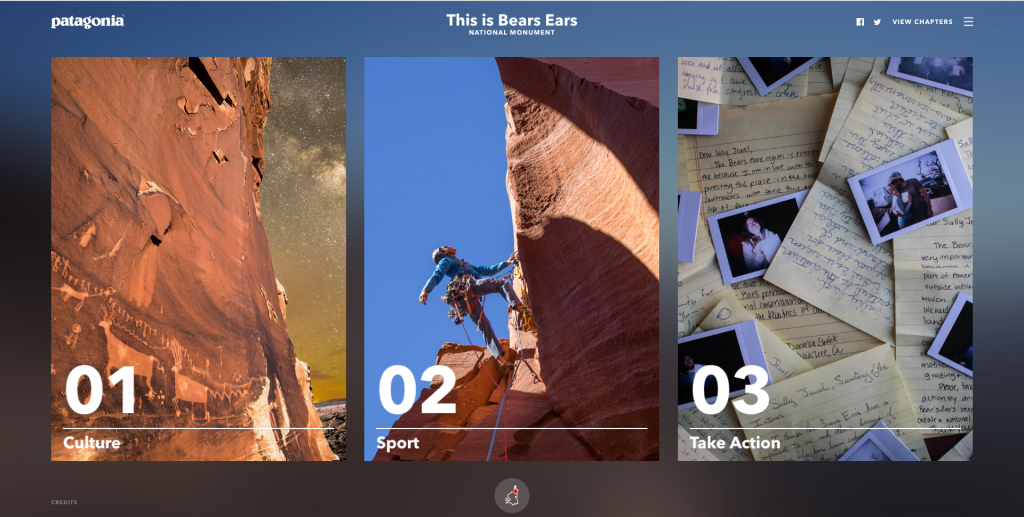
Patagonia’s This is Bears Ears project was a movement to educate the public and push for the monument designation. (Patagonia)
Patagonia’s, “This is Bears Ears,” project was a partnership with Google 360 technology.
Tessa Byars, communications manager for Patagonia, discussed the impact projects like “This is Bears Ears” have had on discussions about public lands issues in the West.
“This film is a result of four-year relationship with the region and its people and is by no means the end of the road of Patagonia’s relationship with Bears Ears National Monument – we will be engaged in protecting this special place for as long as it takes,” Byars said.
The company has also created an ongoing film tour titled, “Discover Bears Ears: An Interactive Film Experience,” shown at Patagonia outlets in Salt Lake City, Reno, San Francisco, Denver and Washington, D.C.
“The response has been very positive,” Byars said. “Our first show at our Salt Lake store was at capacity and people were engaged and passionate about the topic.”
Despite attacks from monument opponents that say companies like Patagonia have no heartfelt interest in Southern Utah (besides economic), company executives have stood firm in their decision to support public lands conservation efforts like the monument designation.
“Bears Ears National Monument is sadly only one example of America’s public lands that is vulnerable to state control and the fossil fuel industry,” Byars said. “Just last month, Maine’s governor asked Trump to rescind the Katahdin Woods and Water National Monument. Patagonia is engaged in the fight for public lands to stay in public hands from coast to coast, and the outdoor industry is in lockstep with us.”
Utah Republican politicians and many southern Utah residents believe state control of public lands is just what is needed. They oppose the type of federal control that companies such as Patagonia advocate.
But monument proponents who pushed for Bears Ears recognize the designation and other public lands issues may now be at the mercy of conservative Republican politicians in Utah, in Congress and in the White House.
“The future of Bears Ears is uncertain,” Byars said. “The Utah delegation has vowed to work with the Trump administration to overturn the designation. No national monument has ever been revoked by a president, and no such action has been tested in court. Congress does have the authority to overturn a monument, but hasn’t done so in the past 50 years.”
Grand Staircase-Escalante
Former President Bill Clinton designated Grand Staircase-Escalante National Monument in 1996 — a surprise move that angered conservative Utahns and Republicans nationwide.
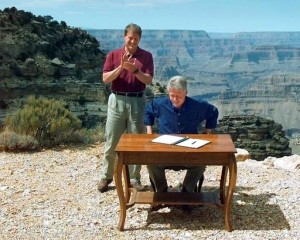
In this Sept. 18, 1996 photo, Vice President Al Gore applauds after President Bill Clinton signs a bill designating about 1.7 million acres of land in southern Utah’s red-rock country as the Grand Staircase-Escalante National Monument. The 20th anniversary of the that event rekindled memories that ignited simmering western frustrations about federal ownership of public lands. (AP Photo/Doug Mills, File)
The monument is managed by the Bureau of Land Management.
“The Grand Staircase-Escalante National Monument’s vast and austere landscape embraces a spectacular array of scientific and historic resources. This high, rugged, and remote region, where bold plateaus and multi-hued cliffs run for distances that defy human perspective, was the last place in the continental United States to be mapped. Even today, this unspoiled natural area remains a frontier, a quality that greatly enhances the monument’s value for scientific study. The monument has a long and dignified human history: it is a place where one can see how nature shapes human endeavors in the American West, where distance and aridity have been pitted against our dreams and courage. The monument presents exemplary opportunities for geologists, paleontologists, archeologists, historians, and biologists.” – Presidential Proclamation 6920, September 18, 1996
Antiquities Act
The American Antiquities Act of 1906 is the same legislation both Clinton and Obama relied on for the authority to designate both Grand Staircase-Escalante and Bears Ears. It gives power to both the president and Congress to “protect special natural, historical and cultural areas as national monuments, expand monument boundaries, direct resources toward monument management and re-designate monuments as national parks,” according to The Wilderness Society.
Be it enacted by the Senate and House of Representatives of the United States of America in Congress assembled, That any person who shall appropriate, excavate, injure, or destroy any historic or prehistoric ruin or monument, or any object of antiquity, situated on lands owned or controlled by the Government of the United States, without the permission of the Secretary of the Department of the Government having jurisdiction over the lands on which said antiquities are situated, shall, upon conviction, be fined in a sum of not more than five hundred dollars or be imprisoned for a period of not more than ninety days, or shall suffer both fine and imprisonment, in the discretion of the court.
Sec. 2. That the President of the United States is hereby authorized, in his discretion, to declare by public proclamation historic landmarks, historic and prehistoric structures, and other objects of historic or scientific interest that are situated upon the lands owned or controlled by the Government of the United States to be national monuments, and may reserve as a part thereof parcels of land, the limits of which in all cases shall be confined to the smallest area compatible with proper care and management of the objects to be protected: Provided, That when such objects are situated upon a tract covered by a bonafied unperfected claim or held in private ownership, the tract, or so much thereof as may be necessary for the proper care and management of the object, may be relinquished to the Government, and the Secretary of the Interior is hereby authorized to accept the relinquishment of such tracts in behalf of the Government of the United States.
Sec. 3. That permits for the examination of ruins, the excavation of archaeological sites, and the gathering of objects of antiquity upon the lands under their respective jurisdictions may be granted by the Secretaries of the Interior, Agriculture, and War to institutions which the may deem properly qualified to conduct such examination, excavation, or gathering, subject to such rules and regulation as they may prescribe: Provided, That the examinations, excavations, and gatherings are undertaken for the benefit of reputable museums, universities, colleges, or other recognized scientific or educational institutions, with a view to increasing the knowledge of such objects, and that the gatherings shall be made for permanent preservation in public museums.
Sec. 4. That the Secretaries of the Departments aforesaid shall make and publish from time to time uniform rules and regulations for the purpose of carrying out the provisions of this Act. – Approved, June 8, 1906
(Data from the National Parks Service)
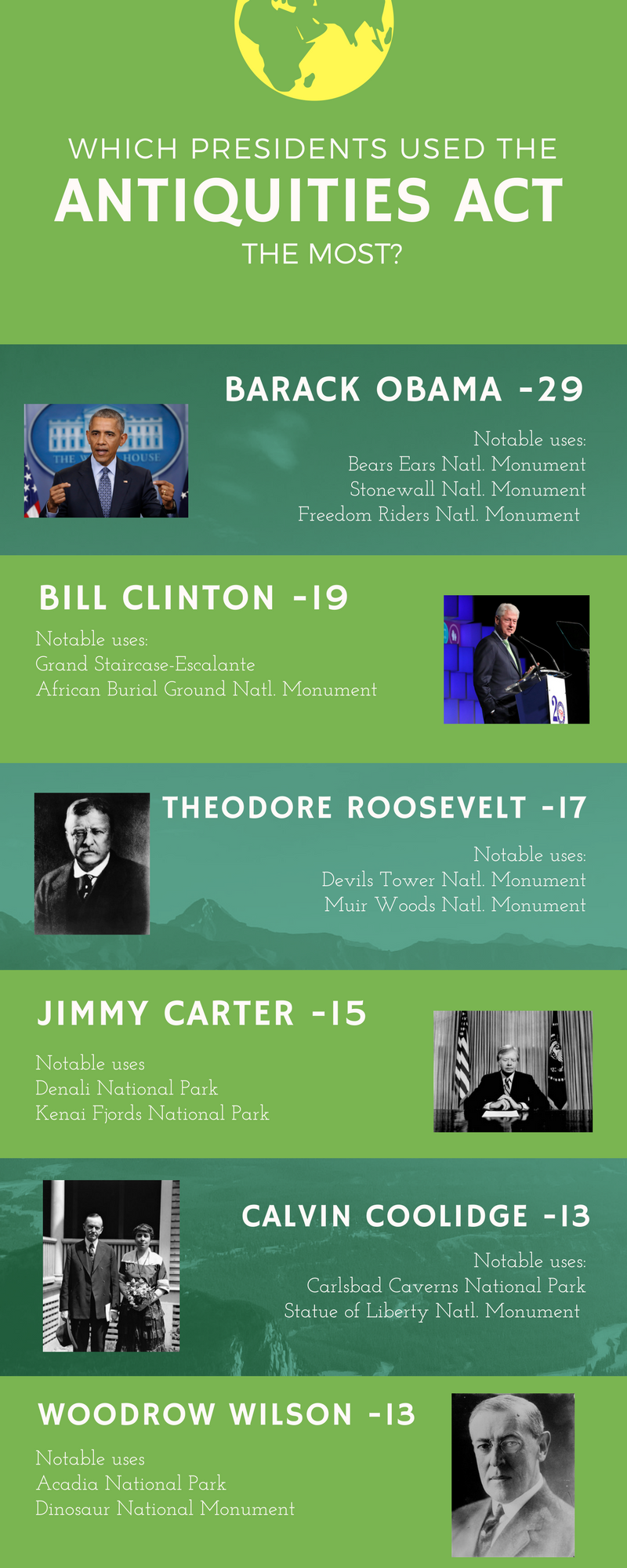
Native Americans
Some Native Americans agree the efforts of both Utah politicians and western environmental groups to involve them in these debates points to a larger issue of token racism.
Regina Lopez-Whiteskunk is a founder of the Bears Ears Inter-tribal Coalition that made one of the first formal proposals regarding the Bears Ears Monument. She was once on the Ute Mountain Ute tribal council in San Juan County, but was voted out in October 2016, along with two other council members who were on the Inter-tribal coalition.
“The land and its precious resources needs to be healed, but there are other wounds as well, which is why healing forms the inner core of our Bears Ears movement. Relationships between tribal nations have been healed as we work together toward a common goal. And now the Bears Ears Inter-Tribal Coalition is looking to heal the relationship with the United States government. We are not wielding the hatchet of war, but rather extending our hand to say: join us in encouraging the spirit of healing,” Lopez-Whiteskunk wrote in an opinion for Indian Country Today.
But Lopez-Whiteskunk is unpopular in San Juan County. Even mentioning her name among locals in San Juan County sparks a fierce debate. Many monument opponents say they believe politicians and activists on both sides of the issue just want Native American support to look like these groups have the tribes’ best interests at heart.
The Bears Ears dilemma has highlighted a rift in the Southwest’s Native American communities. Tribes are often divided on whether federal or state protections are needed to preserve sacred cultural sites, such as Cedar Mesa in San Juan County. Members of Utah-based tribes have also expressed disdain that tribes with no historical or present connection to the Utah lands are seeking to promote federal control.

Utah Dine Bikeyah’s website encourages visitors to contact Secretary Zinke and fight against the potential rescinding of Bears Ears. (Utah Dine Bikeyah)
Moving Forward
Conservationists who supported the monument
Josh Ewing is the director of the stewardship group Friends of Cedar Mesa, based in Blanding, Utah. Ewing was the subject of Patagonia’s “Defined by the Line” video supporting the Bears Ears monument designation and permanent protection of Utah’s public lands.
“Friends of Cedar Mesa is primarily a stewardship group for protected areas,” Ewing said. “We educate visitors on how to visit respectfully, especially around archaeological sites.”
Ewing described his organization’s efforts to work with Utah politicians to create “permanent protections” for lands in southeastern Utah. These efforts were originally focused on the Public Lands Initiative, sponsored by Rep. Bishop.
“We were pretty different. A lot of organizations stopped working on the Public Lands Initiative a long time before we did, but we hung on to the bitter end,” Ewing said. “It made some conservation groups mad, but we really thought we had a chance to reach a compromise.”
Ewing said he sat down with staff members for both Chaffetz and Bishop, and saw a draft of the legislation Bishop hadn’t seen it yet. The final draft presented to Congress was not what these conservation groups wanted.
“The ultimate poison pill in the final bill was leaving the entire Bluff area open to oil and gas development,” Ewing said.
One of the main concerns that would be addressed with permanent protection was the “lack of resources for managing visitation quadruple visitation numbers, with no corresponding increase in rangers or people managing the land,” Ewing said.
“The status quo — treating it like regular old BLM land — is not working,” he said. “There’s irresponsible motorized visitation, looting and vandalism. It’s being managed like everywhere else and not being treated like it’s special, which it is.”
Ewing addressed the tensions that the monument has created in Utah, noting that both sides have been guilty exaggerating their positions.
“There’s an unfortunate lack of listening to each other, which I think is a disease affecting our country,” Ewing said.
“On the one side you’ve got people who said if the monument designation failed there would be oil rigs absolutely everywhere the next day. Then you’ve got people who say that the monument would lead to dozens of helicopters patrolling and kicking people off the land. Obviously those are two exaggerated views, and nothing happens like that,” Ewing said.
“The divide has become stronger and more acute — time will help heal some of these wounds, but they won’t heal overnight,” Ewing said.
Ewing described his personal motivation to support permanent protections for land like Bears Ears.
“Some of it is plain old selfishness,” Ewing said. “I would hate to see the place I love destroyed by inaction. I want to hike out my backyard and not see oil rigs.”
Ewing discussed Friends of Cedar Mesa’s efforts to move on after the designation.
“Our organization has agreements with BLM — we are working on putting together a map of the area and FAQs, like ‘is there a fee to get in,’ those kinds of things,” Ewing said. “We started a hashtag on Twitter, #ReadTheProclamation, which encourages people to read the law of the land, and counter a lot of the misinformation that is out there.”
Locals who opposed the monument
Kara Laws is a small business owner in Blanding. She manages the website and social media accounts for the local grassroots movement Save the Bears Ears. This movement opposed the designation of the monument and is now working with Utah legislators and politicians to urge President Trump to rescind the designation. Laws said earlier this year that the community has faith in Sec. Zinke and was hoping he would visit.
“Ryan Zinke promised to visit if he was named Secretary of the Interior, so we’re counting on that,” Laws said.
Laws described the change in mood after President Obama signed what many conservative monument opponents named a “midnight monument.”
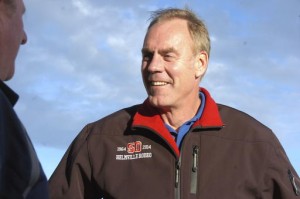
In this Oct. 20, 2016 photo, Rep. Ryan Zinke, R-Mont. speaks with a supporter in Billings, Mont., as he campaigns for re-election. Donald Trump announced his choice of Zinke as Interior secretary Thursday, Dec. 15, 2016, picking a man who should fit smoothly into an administration favoring more energy drilling and less regulation. (AP Photo/Matthew Brown, File)
“The day after the designation — December 29th — there was a press conference of locals from Blanding and Bluff, and there were basic no monument t-shirts to the shirts with angry bears on them. I think that shows how we feel,” Laws said. “Obama was on vacation in Hawaii (when he signed the order). I think people are mad about that.”
Laws said the community’s fears about the monument bringing crowds of people to the land and placing a strain on natural resources have already started to show.
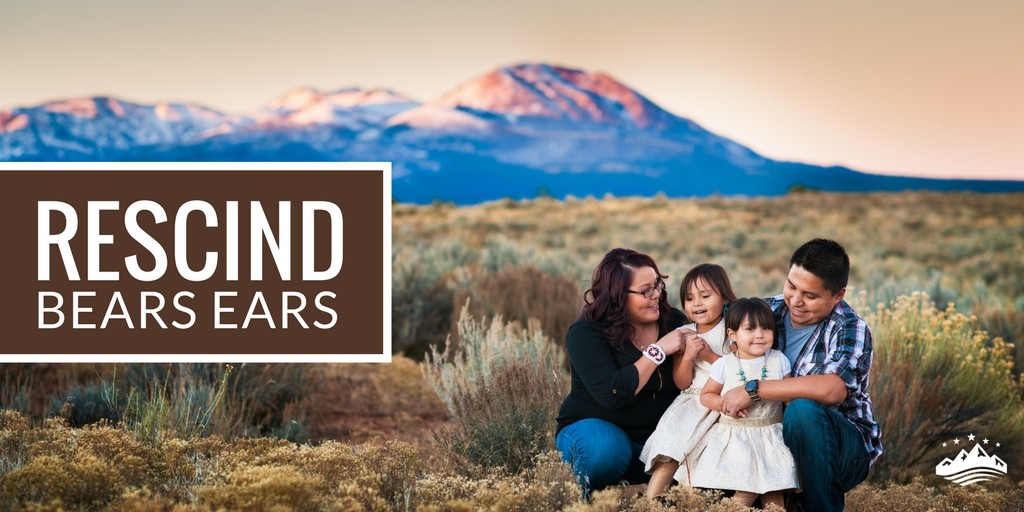
The Sutherland Institute launched the Rescind Bears Ears campaign, a monument opposition movement that focuses primarily on the opinions of San Juan County locals. (Sutherland Institute)
“We’ve already seen an increase in vandalism, and lines of cars on the land,” Laws said.
Laws acknowledged that the community differences between the towns of Blanding and Bluff have played a large role in the years-long tensions.
“Bluff is already a tourist destination, with a 100 percent tourist economy. From 6th grade on, we bus kids to Blanding to go to school,” Laws said. “A lot of people who live in Bluff drive to Blanding, and they don’t see how it would directly affect this community”
“They see more vandalism than we do up here,” Laws said. “I can see how they think somehow a monument would stop these things.”
Laws expressed an opinion common to many local monument opponents: lack of representation.
“What frustrates me most is citizens who live here are not being heard,” Laws said. “Even monument supporters here are not being heard. We’re being drowned out by Patagonia and Utah Dine Bikeyah who have millions of dollars at their disposal.”
“What frustrates me most is citizens who live here are not being heard,” Laws said. “Even monument supporters here are not being heard. We’re being drowned out by Patagonia and Utah Dine Bikeyah, who have millions of dollars at their disposal.”
“If it was just about these communities coming to an agreement among ourselves, it would be a different story,” Laws said. “When people who have never been here before, people from places like Oregon who are telling us how to use our land, it’s offensive.”
“When you look at the history of the land and the history of the monuments, it doesn’t look good,” Laws said.
The fight over Utah’s public lands continues. And if previous struggles are any indication, it is far from over.

